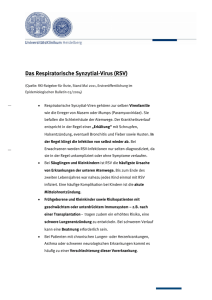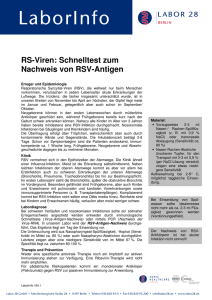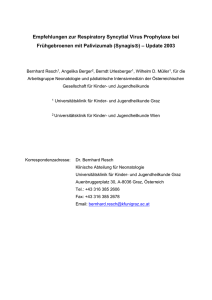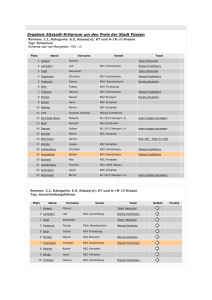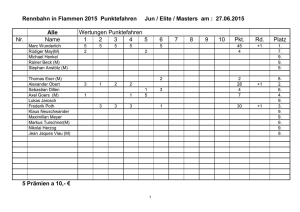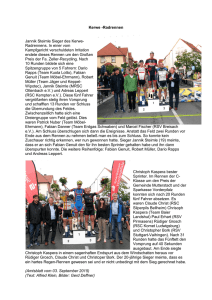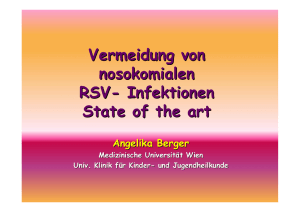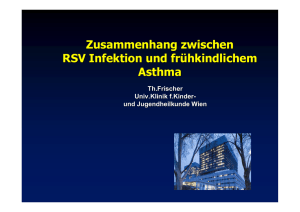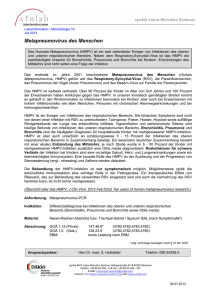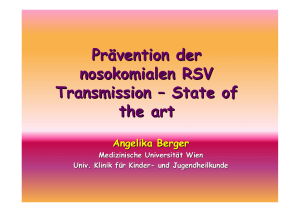RSV_Epidemiologie_und_Praevention
Werbung
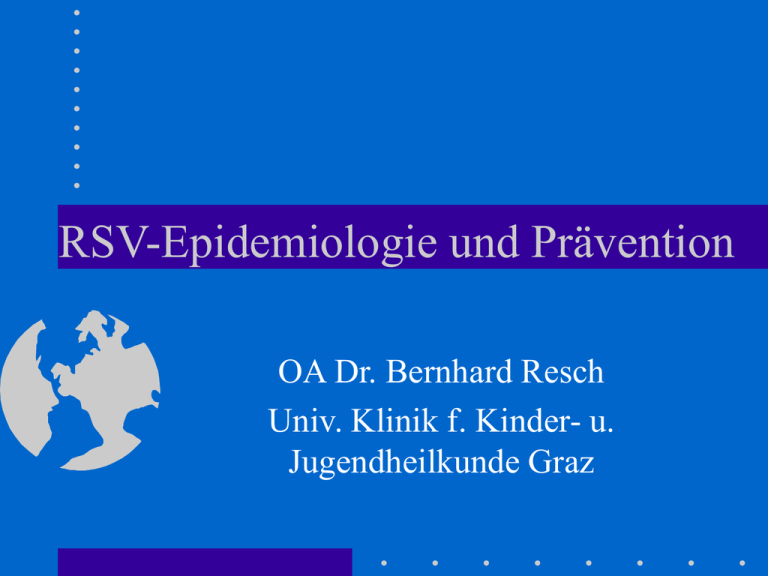
RSV-Epidemiologie und Prävention OA Dr. Bernhard Resch Univ. Klinik f. Kinder- u. Jugendheilkunde Graz Eigene Daten 1994 - 98 Saisonale Verteilung bei 245 RSV-Hospitalisierungen Anzahl der Patienten 60 50 40 51 43 39 37 30 24 17 20 14 7 10 4 3 7 1 0 r z e ar n u är r n M Jä Feb ril p A M ai ni u J li Ju r r r t e er e e s b b b b u g m to u em zem e k t v A O p No De Se Monat Resch et al, Pediatr Infect Dis J 2000; 587-8 Saisonale Verteilung hospitalisierter Kinder mit RSV positiver Atemwegsinfektion von Jänner 1994 - Juni 2002 Univ. Klinik für Kinder- u. Jugendheilkunde Graz 50 Anzahl der Fälle 40 30 20 10 0 9 n. Ju 4 D ez 4 .9 9 n. Ju 5 D ez 5 .9 9 n. Ju 6 D ez 6 .9 9 n. Ju 7 D ez 7 .9 9 n. Ju 8 D ez 8 .9 9 n. Ju 9 D ez 9 .9 0 n. Ju 0 D ez 0 .0 0 n. Ju 1 D ez 1 .0 0 n. Ju 2 RSV Hospitalisierungen Juli 1994 - Juni 2001 in Kiel Weigl et al, Infection 2002; 30: 186-92 10 9 8 7 6 5 4 3 2 1 0 8,9 5,6 3,5 5,5 RSV pos RSV neg 2,9 1,9 1,4 0,4 Be at m un g f 0,02 Ta ge O 2Be da r Ta ge ag e lst Sp ita er eg ra d* Sc hw M on at e) 0,3 te r( Al Mittelwert Vergleich von 58 RSV positiven mit 223 RSV negativen Kindern, die mit Atemwegsinfektion zwischen November 1999 und Oktober 2000 hospitalisiert waren. Alle Unterschiede waren signifikant. Resch et al, Infection 2002; 30: 193-7 16 14 12 10 8 6 4 2 0 14 9 p=0,007 FG RG 2,9 2,9 Be at m un g 1 0,4 Ta ge Ta ge O 2Be da r f 2 1,4 Sp i ta l st ag e on at e) 2 Sc hw er eg ra d* 3,5 Al te r( M Mittelwert Vergleich RSV positiver Atemwegsinfektionen zwischen frühgeborenen (n = 7) und reifgeborenen (n = 51) Kindern Resch et al, Infection 2002; 30: 193-7 mean number Vergleich Frühgeborene mit RSV pos. (n=7) vs. neg. (n=19) Atemwegsinfektion 16 14 12 10 8 6 4 2 0 14 6 p=0,037 2 age (months) 7 p=0,014 FG pos (n = 7) 2,9 2,3 LRI Score 2 1,3 Hosp. days O2 days 1 0,2 FG neg (n = 19) Vent. days Resch et al, Infection 2002; 30: 193-7 RSV - RAD, retrospektive Kontrollgruppen Subjects RSV/Controls Length of follow-up Statistically significant difference in outcomes between groups? 35/35 8 years Yes p < 0.02 Pullan & Hey (1982) 130/111 10 years Yes p < 0.001 McConnochie & Roghmann (1984) 59/177 8 years Yes p < 0.0001 Mok & Simpson (1984) 100/200 7 years Yes NA Study Sims et al (1978) p values RSV - RAD, retrospektive Kontrollgruppen Subjects RSV/Controls Length of follow-up Statistically significant difference in outcomes between groups? Carlsen et al (1987) 51/24 2 years Yes p < 0.01 Murray et al (1992) 73/73 5.5 years Yes p < 0.001 Osundwa (1993) 70/70 1 year Yes p = 0.001 Noble et al (1997) 61/47 Yes OR = 3.59 Study 9–10 years p values/ Odds ratio RSV - RAD, prospektive Studien 4 Odds Ratios (95% CI) • 207 children with mild RSV LRI • Controls had no LRI in the first 3 years of life • Risk for frequent wheeze was still significantly increased at 11 years (p ≤ 0.01) 3 *** *** *** ** 2 NS Age 11 Age 13 1 0 Age 6 Age 8 Frequent wheeze ***p ≤ 0.001 Stein et al. Lancet. 1999;354:541. Stein et al. Lancet. 1999;354:541. * Infrequent wheeze **p ≤ 0.01 *p ≤ 0.05 RSV - RAD, prospektive Studien 40 35 * ** *** 30 % of group • 47 children hospitalized for RSV LRI in the first year of life • 93 controls had no RSV LRI • Risk for wheeze still significantly increased at 7 years (p < 0.0001) 25 ** ** 20 15 † 10 5 0 RSV Controls Wheezing 1 yr Sigurs et al. Am J Respir Crit Crit Care Med. 2000;161:1501. 3 yr RSV Controls Asthma 7 yr *p = 0.003 ***p < 0.0001 **p < 0.001 †p = 0.004 RSV - RAD Fortsetzung: Multivariate Test of Risk Factors for Asthma and “Any Wheezing” in All 140 Children Risk factor Asthma Any wheezing Odds ratio (95% CI) Odds ratio (95% CI) 12.7 5.3 (3.4 - 47.1) (2.2 - 12.5) Hereditary asthma (parents) — 3.0 Male gender — RSV bronchiolitis (1.2 - 7.8) 4.4 (2.0 - 9.8) Sigurs et al. Am J Respir Crit Care Med. 2000;161:1501. RSV-RAD conclusion • 10 Studien mit Kontrollgruppen. 1978 - 2000. • Follow-up 2 - 13 Jahre • In allen Studien: signifikant häufiger „wheezing“ nach RSV Bronchiolitis in den ersten Lebensjahren. • Zusammenhang mit allergischer Sensitivierung unklar. • Variable Co-Faktoren: – Familiäre Belastung (Atopie u/o Asthma), Stilldauer, passive Belastung durch Tabakrauch (einschließlich pränatal) RSV-RAD conclusion Literature Summary: 100 82% Patients affected (%) 80 69% 55% 60 40 31% 20 0 2 3.5 4-5 Years after initial RSV infection Wolff, Fiedelman. J Ped Pharm Pract. 1999;4:23. 6-8 • Strong association between RSV LRI and RAD during childhood, which diminishes over time • 82% had RAD up to 2 yr post RSV • 31% had RAD up to 8 yr post RSV 120 100 80 60 * * * 40 Palivizumab Vehicle 24 hr before inoculation Intranasal 0 Endotracheal 20 Intranasal (ng/mg tissue weight) Neurogenic inflammation Palivizumab inhibiert die RSV-induzierte neurogenmediierte pulmonale Inflammation *Difference statistically significant 72 hr after inoculation Piedimonte et al. Pediatr Res. 2000;47:351. Einfluß von RSV-IGIV auf RAD • 13 Kinder mit BPD und RSV-IGIV über eine RSV Saison • 26 matched controls (mit BPD) – mittleres Alter 8.60.5 vs. 9.0 0.2 Jahre • • • • 6/13 vs. 21/26 hatten eine dokumentierte RSV Infektion Bessere Lungenfunktionsparameter (z.B. FEV1/FVC) (p < 0.02) Weniger Atopie (p < 0.04) Weniger Schulfehltage (p = 0.01), weniger Erkältungen (p < 0.03), und weniger Asthma-Anfälle (p < 0.04) • geringe Reduktion der Rehospitalisierungen und weniger antiobstruktive Medikation Wenzel et al, Am J Respir Crit Care Med 2000; 161:A898 Bronchiolitis Hospitalizations Among US Children Younger Than 1 Year or 1 to 4 Years, by Month and Year of Discharge, 1980-1996 Shay et al. JAMA. 1999;282:1440. Welche ökonomische und gesundheitliche Belastung stellt die RSV Infektion in den ersten Lebensjahren dar? • US Studie (Daten von der „Agency for Health Care Policy and Research“) • Retrospektive Analyse aller Kinder unter 4 Jahren im Zeitraum 1993-95 anhand des IC-9-Codes (RSV Pneumonie 480.1) • 10.767 Fälle, Spitalskosten 295 - 392 Mio Dollar (1998)/ Jahr • Mittlere Aufenthaltsdauer: – – – – – – Keine Komorbidität CHD azyanot. zyanot. CLD Beatmung Beatmung + CLD 4.9 (Tage) 8.6 13.1 17.3 20.0 38.9 Howard et al, J Pediatr 2000;137:227 Ökonomische und gesundheitliche Belastung - Fortsetzung • Einfluß von Beatmung auf mittlere Gesamtkosten: – keine Komorbidität – CLD $92 150 (mean) 9.5x (mean charges multiple) $182 690 4.4 x • Case fatality rate: – – – – – – keine Komorbidität CHD azyanot. CHD zyanot. Beatmung ohne Komorb. Beatmung + zyanot. CHD Beatmung + CLD 0.1 % 0.0 % CHD allgemein 4.9% 0.9 % 7.6 % 39.6 % 13.2 CLD allgemein 6.9% Howard et al, J Pediatr 2000;137:227 Studienergebnisse I 12 10,6 10 8 6 4,8 3,2 4 1,5 2 2,3 2,4 2,1 1,6 Im pa ct R EA C H O U T 98 O U T 99 W 98 -2 78 B. EX .A . W 99 -3 10 0 Placebo Synagis Studienergebnisse II 14 12,8 12 10 7,9 8 6 4 4,0 3,9 OUT 98 OUT 99 Placebo Synagis 2,7 2 0 Impact REACH BPDer ! Austrian RSV 29-32 Study Group • • • • • • • Österreichweite Multicenterstudie Fragestellung: generelle RSV-Prophylaxe bei FG 29-32 SSW? prospektive selektierte Beobachtungsstudie Erfassung der RSV-Rehospitalisierungsrate Einschluß aller 29-32er geboren 1.6.2001- 31.12.2002 Studienende (Beobachtungszeitraum) 1.6.2003 aktueller Teilnehmerstand: – Bregenz, Feldkirch, Graz, Innsbruck, Kirchdorf, Klagenfurt, Krems, Leoben, Linz, Oberwart, Reutte, Salzburg, Steyr, St. Pölten, Tulln, Villach, Vöcklabruck, Wels, Wien Glanzing, Wien Preyer, Wien SMZ Ost, Wr. Neustadt, Zwettl.

